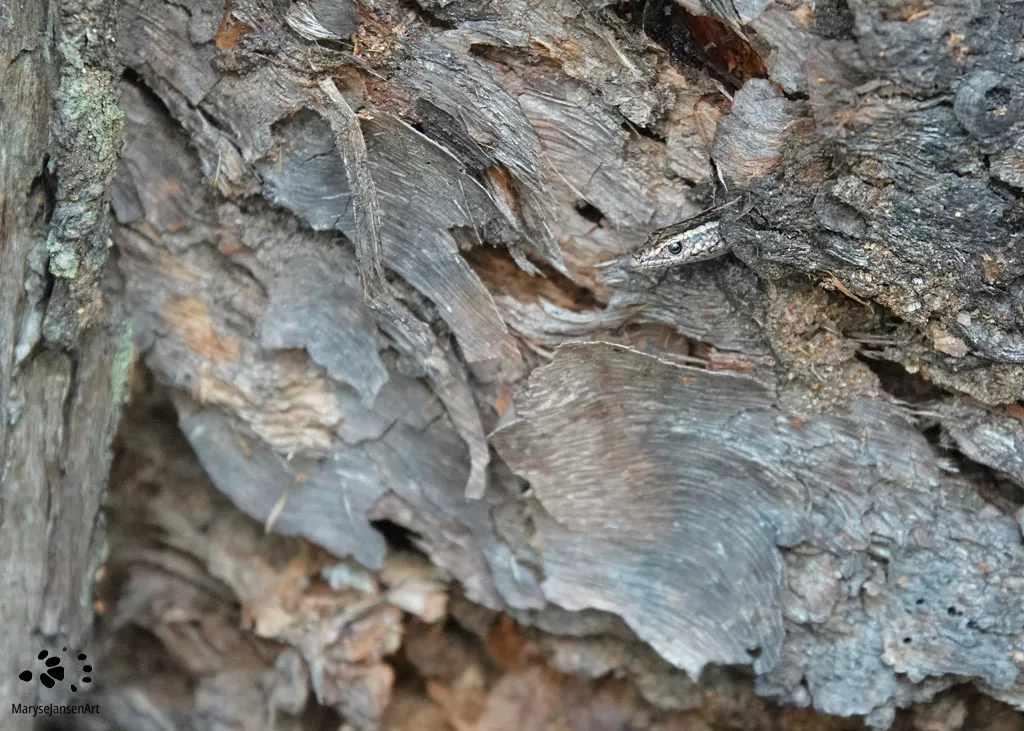Wildlife and Wildflower Photography with marysejansenart
Is there always something new to discover when you go on a nature walk?
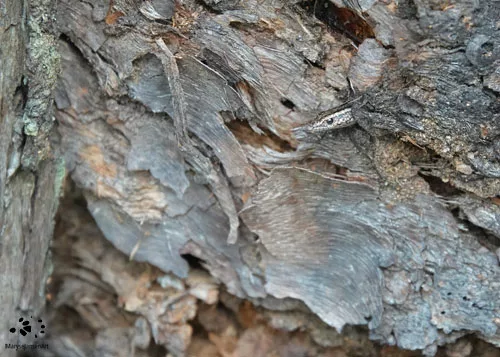
Table of Contents
A nature walk with a focus on the undergrowth
As I am walking through the bush, today my attention is drawn to the undergrowth. There’s a lot going on here at the moment. It is interesting, I do not plan these things up front. I just go for a walk in a place that I feel drawn to on the day with an intention to film an episode of ‘Come for a walk in the Australian Bush’, and to take photos of course! Sometimes, I begin my walk and I feel a little bit of worry. Will there be enough to see here to create an episode?
But as you may have noticed throughout this year, nature never fails to deliver, as long as you have an open mind! Check out my post about Wildlife Spotting for more about this. Each episode of my series was literally filmed during one single walk, and there has never been a walk that I had to discard because there wasn’t enough to see. In fact, each walk has brought new things to discover! For you as the viewer, but also for me. I have spent many hours trying to identify all the new species I saw, and I can share with you that this has not always been easy.
Today, I am amazed again by the things I see, some of which I have seen before and some of which I haven’t! And I am as always excited to be able to share it all with you!
Red Robber Flies
During this walk, I spot a pair of mating insects. At first glance, they look a lot like dragonflies, but they are in a different type of mating position. Instead of the mating wheel, their tail ends are attached to each other. Also, upon closer examination I notice a few other differences. The wings look different and so do the eyes and the legs. These are not dragonflies! But what are they??
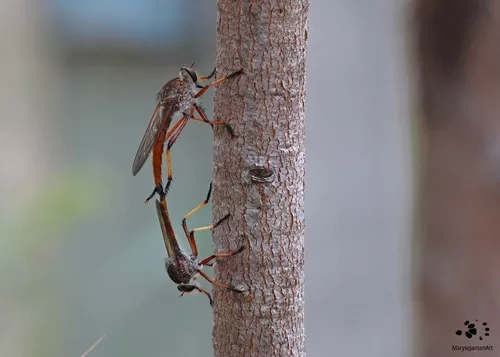
After a big search I land on Robber Flies. I had never heard of these before, but apparently there are quite a number of species, although I can’t find exact information on how many. At least 10 subfamilies have been documented in the Brisbane area!
These particular ones are Red Robber Flies. They are hunters. Like dragonflies they hunt on sight and catch their insect prey in the air. The Robber Flies catch their prey with their legs and then use their snout to inject a venom which contains enzymes that predigest the insides of the prey. The Robber Flies then suck out the contents with their snout and discard the empty exoskeleton. Can you see why they are also known as Assassin Flies? Wow, there is always something new to be learned!
Elegant Snake-eyed Skink
A little while later, I also notice a little skink poking its head out from between the layers of bark on a tree trunk. It’s lying in ambush, waiting for a small insect to wander past. Check it out in the featured image!
Over 430 species of skinks have been described in Australia, so again it is a bit of an ordeal to identify it. It really is a matter of ruling out and narrowing down options, until I conclude that this is an Elegant Snake-eyed Skink! It is a very small skink, only 41mm long (not counting the tail). It can be seen in coastal parts of eastern Australia between Ingham (QLD) and Jervis Bay (NSW). This species inhabits trees and rocks and may also adapt to human structures. It has beautiful stripes in various shades of brown from very pale to dark and also black.
It ventures out of its hiding place, foraging along a fallen branch. I keep very, very still as it is quite skittish. It may have an appetite for little ants, but the Bull Ants that are also wandering around in its little world on the fallen branch are absolutely a few sizes to big for the skink! It appears that the little skink is quite terrified that they might pince its nose with their big jaws, so each time a Bull Ant comes near, it runs for cover. A minute later it carefully appears again. I don’t think it is having any luck in the hunt…
Thankfully for the little skink, the Bull Ants appear to be moving house as they are carrying their eggs around. So perhaps, when that’s done, the skink might be able to reclaim its territory.
Common Archtail
Another beautiful insect catches my eye. It is yellow and black and has stunning green eyes! This one ìs a dragonfly! Quite different from the ones I have encountered so far. The slender tail has the shape of an arch and upon consulting my guidebook I learn that it belongs to the genus of Archtails! Very fitting!
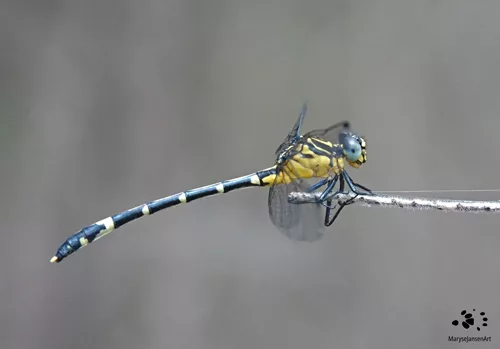
Like the dragonflies I described in my recent post, this genus also belongs to the family of Libellulidae. There are only 4 species of Archtails in Australia and this is the Common Archtail. It can be found in large parts of eastern Australia and also along the Top End in the Northern Territory. It has a wingspan of around 5-6cm and its body is 3.5-4cm long. They sometimes are known by the name of Stream Watcher.
I don’t just look for animals, the flora is also incredibly interesting and often brings new surprises. As I have mentioned before in my blog post series ‘Zooming in on small wildflowers’, it is rewarding to look closely. Small wildflowers are often overlooked, which is a shame as they often hold an intricate beauty.
Blotched Hyacinth Orchid
Today I spot a very special flower, that I have only seen once or twice before. It is an orchid! A leafless green to black stem rises up with a height of 40-100cm from the forest floor, carrying up to 60 flowers which are arranged in a hyacinth-like fashion. The flowers are white to pink with heavy red to purple blotches. Very pretty indeed! This orchid can be found in open Eucalyptus forest in eastern Australia and it flowers during summer.
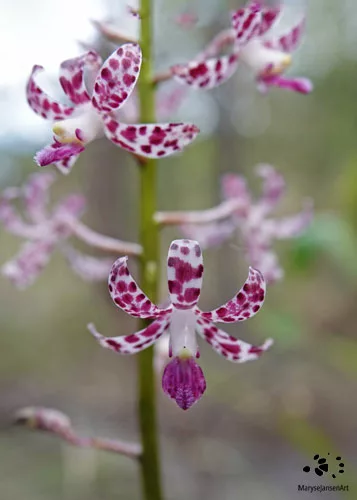
When not flowering, the plant spends its life underground. Only once a year can you be lucky enough to see the flowering stems grow up out of the earth! Underground, they live in a partnership with a fungus to which they attach their roots. This way the orchid gets some nutrients. The green stem does photosynthesise, despite the fact that there are no leaves, and the orchid shares its produced carbohydrates with their fungus host. This partnership is called a myco-heterotrophic relationship. Isn’t that interesting?! It shows why people haven’t been able to grow these orchids! They are part of a complex ecosystem and they can’t grow without it!
Isn’t it amazing how much we learned today from going on just one single walk! If you’d like to see the Red Robber Flies, the Elegant Snake-eyed Skink, the Common Archtail, the Blotched Hyacinth Orchid and more, then watch below the latest episode of ‘Come for a walk in the Australian Bush’!
To view episode 1 of ‘Life in the Undergrowth’, check out my first post about dragonflies.
If you are interested in purchasing ‘Elegant Snake-eyed Skink’ or would like to see what the image looks like on the various products, please head to my shop. If you prefer ‘Red Robber Flies Mating’, click shop here, for ‘Common Archtail’, click shop here and for ‘Blotched Hyacinth Orchid’, click shop here.

